Thiazole–Chalcone Hybrids as Prospective Antitubercular and Antiproliferative Agents: Design, Synthesis, Biological, Molecular Docking Studies and In Silico ADME Evaluation
Abstract
1. Introduction
2. Results and Discussion
2.1. Chemistry
2.2. Biological Studies
2.2.1. Antitubercular Activity
2.2.2. Antiproliferative and Cytotoxic Activities
2.3. Computational Studies
2.3.1. Molecular Docking Studies
2.3.2. In Silico Drug Likeliness Studies
3. Materials and Methods
3.1. Chemistry
3.2. Biological Studies
3.2.1. Antitubercular Activity
3.2.2. Antiproliferative and Cytotoxic Activity
3.3. Computational Studies
3.3.1. Molecular Docking Studies
3.3.2. In Silico Drug Likeliness Studies
4. Conclusions
Supplementary Materials
Author Contributions
Funding
Acknowledgments
Conflicts of Interest
Sample Availability
References
- Novel Drug Approvals for 2020. Available online: https://www.fda.gov/drugs/new-drugs-fda-cders-new-molecular-entities-and-new-therapeutic-biological-products/novel-drug-approvals-2020 (accessed on 20 December 2020).
- Ayati, A.; Emami, S.; Asadipour, A.; Shafiee, A.; Foroumadi, A. Recent applications of 1, 3-thiazole core structure in the identification of new lead compounds and drug discovery. Eur. J. Med. Chem. 2015, 5, 699–718. [Google Scholar] [CrossRef] [PubMed]
- Chhabria, T.M.; Patel, S.; Modi, P.; Brahmkshatriya, S.P. Thiazole: A review on chemistry, synthesis and therapeutic importance of its derivatives. Curr. Top. Med. Chem. 2016, 16, 2841–2862. [Google Scholar] [CrossRef] [PubMed]
- Chunlin, Z.; Wen, Z.; Chunquan, S.; Wannian, Z.; Chengguo, X.; Zhenyuan, M. Chalcone: A Privileged Structure in Medicinal Chemistry. Chem. Rev. 2017, 117, 7762–7810. [Google Scholar] [CrossRef]
- Yazdan, K.S.; Sagar, G.V.; Shaik, B.A. Biological and synthetic potentiality of chalcones: A review. J. Chem. Pharm. Res. 2015, 7, 829–842. [Google Scholar]
- Abhale, Y.K.; Shinde, A.; Deshmukh, K.K.; Nawale, L.; Sarkar, D.; Mhaske, P.C. Synthesis, antitubercular and antimicrobial potential of some new thiazole substituted thiosemicarbazide derivatives. Med. Chem. Res. 2017, 26, 2557–2567. [Google Scholar] [CrossRef]
- Dhumal, S.T.; Deshmukh, A.R.; Bhosle, M.R.; Khedkar, V.M.; Nawale, L.U.; Sarkar, D.; Mane, R.A. Synthesis and antitubercular activity of new 1, 3, 4-oxadiazoles bearing pyridyl and thiazolyl scaffolds. Bioorg. Med. Chem. Lett. 2016, 26, 3646–3651. [Google Scholar] [CrossRef]
- Güzeldemirci, N.U.; Karaman, B.; Küçükbasmaci, Ö. Antibacterial, antitubercular and antiviral activity evaluations of some arylidenehydrazide derivatives bearing imidazo [2,1-b] thiazole moiety. Turk. J. Pharm. Sci. 2017, 14, 157. [Google Scholar] [CrossRef]
- Yan, M.; Xu, L.; Wang, Y.; Wan, J.; Liu, T.; Liu, W.; Wan, Y.; Zhang, B.; Wang, R.; Li, Q. Opportunities and challenges of using five-membered ring compounds as promising antitubercular agents. Drug. Dev. Res. 2020, 81, 402–418. [Google Scholar] [CrossRef]
- Kryshchyshyn, A.; Roman, O.; Lozynskyi, A.; Lesyk, R. Thiopyrano [2,3-d]Thiazoles as New Efficient Scaffolds in Medicinal Chemistry. Sci. Pharm. 2018, 86, 26. [Google Scholar] [CrossRef]
- Gundlewad, G.B.; Patil, B.R. Synthesis and Evaluation of Some Novel 2-Amino-4-Aryl Thiazoles for Antitubercular Activity. J. Het. Chem. 2018, 55, 769–774. [Google Scholar] [CrossRef]
- Shaik, A.B.; Bhandare, R.R.; Nissankararao, S.; Edis, Z.; Tangirala, N.R.; Shahanaaz, S.; Rahman, M.M. Design, facile synthesis and characterization of dichloro substituted chalcones and dihydropyrazole derivatives for their antifungal, antitubercular and antiproliferative activities. Molecules 2020, 25, 3188. [Google Scholar] [CrossRef]
- Pola, S.; Banoth, K.K.; Sankaranarayanan, M.; Ummani, R.; Garlapati, A. Design, synthesis, in silico studies, and evaluation of novel chalcones and their pyrazoline derivatives for antibacterial and antitubercular activities. Med. Chem. Res. 2020, 29, 1819–1835. [Google Scholar] [CrossRef]
- Burmaoglu, S.; Algul, O.; Gobek, A.; Aktas, A.D.; Ulger, M.; Erturk, B.G.; Kaplan, E.; Dogen, A.; Aslan, G. Design of potent fluoro-substituted chalcones as antimicrobial agents. J. Enzyme. Inhib. Med. Chem. 2017, 32, 490–495. [Google Scholar] [CrossRef]
- Borcea, A.-M.; Ionuț, I.; Crișan, O.; Oniga, O. An Overview of the Synthesis and Antimicrobial, Antiprotozoal, and Antitumor Activity of Thiazole and Bisthiazole Derivatives. Molecules 2021, 26, 624. [Google Scholar] [CrossRef]
- Kishor, P.; Ramana, K.V.; Shaik, A.B. Antitubercular evaluation of isoxazolyl chalcones. Res. J. Pharm. Biol. Chem. Sci. 2017, 8, 730–735. [Google Scholar]
- Lokesh, B.V.; Prasad, Y.R.; Shaik, A.B. Synthesis and biological activity of novel 2, 5-dichloro-3-acetylthiophene chalcone derivatives. Ind. J. Pharm. Educ. Res. 2017, 51, 679–690. [Google Scholar] [CrossRef]
- De Santana, T.I.; De Oliveira, B.M.; De Moraes, G.P.A.; Da Cruz, A.C.; Da Silva, T.G.; Leite, A.C. Synthesis, anticancer activity and mechanism of action of new thiazole derivatives. Eur. J. Med. Chem. 2018, 20, 874–886. [Google Scholar] [CrossRef]
- Gomha, S.M.; Edrees, M.M.; Altalbawy, F.M.A. Synthesis and Characterization of Some New Bis-Pyrazolyl-Thiazoles Incorporating the Thiophene Moiety as Potent Anti-Tumor Agents. Int. J. Mol. Sci. 2016, 17, 1499. [Google Scholar] [CrossRef]
- Takac, P.; Kello, M.; Vilkova, M.; Vaskova, J.; Michalkova, R.; Mojzisova, G.; Mojzis, J. Antiproliferative Effect of Acridine Chalcone Is Mediated by Induction of Oxidative Stress. Biomolecules 2020, 10, 345. [Google Scholar] [CrossRef]
- Gomha, S.M.; Ahmed, S.A.; Abdelhamid, A.O. Synthesis and Cytotoxicity Evaluation of Some Novel Thiazoles, Thiadiazoles, and Pyrido [2,3-d][1,2,4]triazolo[4,3-a]pyrimidin-5(1H)-ones Incorporating Triazole Moiety. Molecules 2015, 20, 1357–1376. [Google Scholar] [CrossRef]
- Patel, S.; Patle, R.; Parameswaran, P.; Jain, A.; Shard, A. Design, computational studies, synthesis and biological evaluation of thiazole-based molecules as anticancer agents. Eur. J. Pharm. Sci. 2019, 134, 20–30. [Google Scholar] [CrossRef]
- Abu-Melha, S.; Edrees, M.M.; Salem, H.H.; Kheder, N.A.; Gomha, S.M.; Abdelaziz, M.R. Synthesis and biological evaluation of some novel thiazole-based heterocycles as potential anticancer and antimicrobial agents. Molecules 2019, 24, 539. [Google Scholar] [CrossRef]
- Farghaly, T.A.; Masaret, G.S.; Muhammad, Z.A.; Harras, M.F. Discovery of thiazole-based-chalcones and 4-hetarylthiazoles as potent anticancer agents: Synthesis, docking study and anticancer activity. Bioorg. Chem. 2020, 98, 103761. [Google Scholar] [CrossRef]
- Altıntop, M.D.; Sever, B.; Akalın, Ç.G.; Özdemir, A. Design, synthesis, and evaluation of a new series of thiazole-based anticancer agents as potent Akt inhibitors. Molecules 2018, 23, 1318. [Google Scholar] [CrossRef]
- Spanò, V.; Attanzio, A.; Cascioferro, S.; Carbone, A.; Montalbano, A.; Barraja, P.; Tesoriere, L.; Cirrincione, G.; Diana, P.; Parrino, B. Synthesis and Antitumor Activity of New Thiazole Nortopsentin Analogs. Mar. Drugs 2016, 14, 226. [Google Scholar] [CrossRef]
- Shaik, A.B.; Bhandare, R.R.; Nissankararao, S.; Lokesh, B.V.; Shahanaaz, S.; Rahman, M.M. Synthesis, and biological screening of chloropyrazine conjugated benzothiazepine derivatives as potential antimicrobial, antitubercular and cytotoxic agents. Arab. J. Chem. 2021, 14, 102915. [Google Scholar] [CrossRef]
- Wang, Y.; Zhang, W.; Dong, J.; Gao, J. Design, synthesis and bioactivity evaluation of coumarin-chalcone hybrids as potential anticancer agents. Bioorg. Chem. 2020, 95, 103530. [Google Scholar] [CrossRef]
- Shaik, A.; Bhandare, R.R.; Palleapati, K.; Nissankararao, S.; Kancharlapalli, V.; Shaik, S. Antimicrobial, Antioxidant, and Anticancer Activities of Some Novel Isoxazole Ring Containing Chalcone and Dihydropyrazole Derivatives. Molecules 2020, 25, 1047. [Google Scholar] [CrossRef]
- Madhavi, S.; Sreenivasulu, R.; Yazala, J.P.; Raju, R.R. Synthesis of chalcone incorporated quinazoline derivatives as anticancer agents. Saudi. Pharml. J. 2017, 25, 275–279. [Google Scholar] [CrossRef]
- Rashdan, H.R.M.; Abdelmonsef, A.H.; Shehadi, I.A.; Gomha, S.M.; Soliman, A.M.M.; Mahmoud, H.K. Synthesis, Molecular Docking Screening and Anti-Proliferative Potency Evaluation of Some New Imidazo[2,1-b]Thiazole Linked Thiadiazole Conjugates. Molecules 2020, 25, 4997. [Google Scholar] [CrossRef]
- Madhavi, S.; Sreenivasulu, R.; Yousuf, A.M.; Jawed, A.M.; Ramesh, R.R. Synthesis, biological evaluation and molecular docking studies of pyridine incorporated chalcone derivatives as anticancer agents. Lett. Org. Chem. 2016, 13, 682–692. [Google Scholar] [CrossRef]
- Djukic, M.; Fesatidou, M.; Xenikakis, I.; Geronikaki, A.; Angelova, V.T.; Savic, V.; Pasic, M.; Krilovic, B.; Djukic, D.; Gobeljic, B.; et al. In vitro antioxidant activity of thiazolidinone derivatives of 1, 3-thiazole and 1, 3, 4-thiadiazole. Chem.-Biol. Interact. 2018, 286, 119–131. [Google Scholar] [CrossRef] [PubMed]
- Adole, V.A.; More, R.A.; Jagdale, B.S.; Pawar, T.B.; Chobe, S.S. Efficient synthesis, antibacterial, antifungal, antioxidant and cytotoxicity study of 2-(2-hydrazineyl) thiazole derivatives. ChemistrySelect 2020, 5, 2778–2786. [Google Scholar] [CrossRef]
- Nastasă, C.; Tiperciuc, B.; Duma, M.; Benedec, D.; Oniga, O. New hydrazones bearing thiazole scaffold: Synthesis, characterization, antimicrobial, and antioxidant investigation. Molecules 2015, 20, 17325–17338. [Google Scholar] [CrossRef]
- Polo, E.; Ibarra-Arellano, N.; Prent-Peñaloza, L.; Morales-Bayuelo, A.; Henao, J.; Galdámez, A.; Gutiérrez, M. Ultrasound-assisted synthesis of novel chalcone, heterochalcone and bis-chalcone derivatives and the evaluation of their antioxidant properties and as acetylcholinesterase inhibitors. Bioorg. Chem. 2019, 90, 103034. [Google Scholar] [CrossRef]
- Wang, J.; Huang, L.; Cheng, C.; Li, G.; Xie, J.; Shen, M.; Chen, Q.; Li, W.; He, W.; Qiu, P.; et al. Design, synthesis and biological evaluation of chalcone analogues with novel dual antioxidant mechanisms as potential anti-ischemic stroke agents. Acta Pharm. Sin. B 2019, 9, 335–350. [Google Scholar] [CrossRef]
- Al Zahrani, N.A.; El-Shishtawy, R.M.; Elaasser, M.M.; Asiri, A.M. Synthesis of Novel Chalcone-Based Phenothiazine Derivatives as Antioxidant and Anticancer Agents. Molecules 2020, 25, 4566. [Google Scholar] [CrossRef]
- Asiri, A.M.; Khan, S.A. Synthesis and Anti-Bacterial Activities of a Bis-Chalcone Derived from Thiophene and Its Bis-Cyclized Products. Molecules 2011, 16, 523–531. [Google Scholar] [CrossRef]
- Kadhim, A.J.; Mohammed, J.H.; Aljamali, N.M. Thiazole Amide Derivatives (Synthesis, Spectral Investigation, Chemical Properties, Antifungal Assay). NeuroQuantology 2020, 18, 16. [Google Scholar] [CrossRef]
- Kucerova-Chlupacova, M.; Vyskovska-Tyllova, V.; Richterova-Finkova, L.; Kunes, J.; Buchta, V.; Vejsova, M.; Paterova, P.; Semelkova, L.; Jandourek, O.; Opletalova, V. Novel Halogenated Pyrazine-Based Chalcones as Potential Antimicrobial Drugs. Molecules 2016, 21, 1421. [Google Scholar] [CrossRef]
- Shaik, A.B.; Yejella, R.P.; Shaik, S. Synthesis, Antimicrobial, and Computational Evaluation of Novel Isobutylchalcones as Antimicrobial Agents. Int. J. Med. Chem. 2017, 2017, 6873924. [Google Scholar] [CrossRef]
- Singh, G.; Arora, A.; Kalra, P.; Maurya, I.K.; Ruizc, C.E.; Estebanc, M.A.; Sinha, S.; Goyal, K.; Sehgal, R. A strategic approach to the synthesis of ferrocene appended chalcone linked triazole allied organosilatranes: Antibacterial, antifungal, antiparasitic and antioxidant studies. Bioorg. Med. Chem. 2019, 27, 188–195. [Google Scholar] [CrossRef]
- Shaik, A.B.; Lohitha, S.V.; Puttagunta, S.B.; Shaik, A.; Supraja, K.; Sai, H.K. Synthesis and screening of novel lipophilic diarylpropeones as prospective antitubercular, antibacterial and antifungal agents. Biointerface Res. Appl. Chem. 2019, 9, 3912–3918. [Google Scholar] [CrossRef]
- Mellado, M.; Espinoza, L.; Madrid, A.; Mella, J.; Chávez-Weisser, E.; Diaz, K.; Cuellar, M. Design, synthesis, antifungal activity, and structure–activity relationship studies of chalcones and hybrid dihydrochromane–chalcones. Mol. Divers. 2019, 3, 1–3. [Google Scholar] [CrossRef]
- Lagu, S.B.; Rajendra, P.Y.; Srinath, N.; Afzal, B.S. Synthesis. antibacterial, antifungal antitubercular activities and molecular docking studies of nitrophenyl derivatives. Int. J. Life Sci. Pharma Res. 2019, 9, 54–64. [Google Scholar] [CrossRef]
- Sun, N.; Lu, Y.J.; Chan, F.Y.; Du, R.L.; Zheng, Y.Y.; Zhang, K.; So, L.Y.; Abagyan, R.; Zhuo, C.; Leung, Y.C.; et al. A thiazole orange derivative targeting the bacterial protein FtsZ shows potent antibacterial activity. Front. Microbiol. 2017, 8, 855. [Google Scholar] [CrossRef]
- Abdel-Latif, E.; Almatari, A.S.; Abd-ElGhani, G.E. Synthesis and Antibacterial Evaluation of Some New Thiazole-Based Polyheterocyclic Ring Systems. J. Heterocycl. Chem. 2019, 56, 1978–1985. [Google Scholar] [CrossRef]
- Vegesna, S.R.; Prasad, Y.R.; Afzal, B.S. Antimicrobial evaluation of some novel pyrazine based chalcones. Int. J. Adv. Pharm. Sci. 2017, 8, 11–18. [Google Scholar]
- Özdemir, A.; Altıntop, M.D.; Sever, B.; Gençer, H.K.; Kapkaç, H.A.; Atlı, Ö.; Baysal, M. A New Series of Pyrrole-Based Chalcones: Synthesis and Evaluation of Antimicrobial Activity, Cytotoxicity, and Genotoxicity. Molecules 2017, 22, 2112. [Google Scholar] [CrossRef]
- Tang, X.; Su, S.; Chen, M.; He, J.; Xia, R.; Guo, T.; Chen, Y.; Zhang, C.; Wang, J.; Xue, W. Novel chalcone derivatives containing a 1, 2, 4-triazine moiety: Design, synthesis, antibacterial and antiviral activities. RSC. Adv. 2019, 9, 6011–6020. [Google Scholar] [CrossRef]
- Lagu, S.B.; Yejella, R.P.; Bhandare, R.R.; Shaik, A.B. Design, Synthesis, and Antibacterial and Antifungal Activities of Novel Trifluoromethyl and Trifluoromethoxy Substituted Chalcone Derivatives. Pharmaceuticals 2020, 13, 375. [Google Scholar] [CrossRef] [PubMed]
- Reddy, P.V.; Hridhay, M.; Nikhil, K.; Khan, S.; Jha, P.N.; Shah, K.; Kumar, D. Synthesis and investigations into the anticancer and antibacterial activity studies of β-carboline chalcones and their bromide salts. Bioorg. Med. Chem. Lett. 2018, 28, 1278–1282. [Google Scholar] [CrossRef]
- Khan, S.A.; Asiri, A.M. Green synthesis, characterization and biological evaluation of novel chalcones as antibacterial agents. Arab. J. Chem. 2017, 10, S2890-5. [Google Scholar] [CrossRef]
- Zhang, M.; Prior, A.M.; Maddox, M.M.; Shen, W.J.; Hevener, K.E.; Bruhn, D.F.; Lee, R.B.; Singh, A.P.; Reinicke, J.; Simmons, C.J.; et al. Pharmacophore modeling, synthesis, and antibacterial evaluation of chalcones and derivatives. ACS. Omega. 2018, 3, 18343–18360. [Google Scholar] [CrossRef]
- Gomtsyan, A. Heterocycles in drugs and drug discovery. Chem. Heterocycl. Com. 2012, 48, 7–10. [Google Scholar] [CrossRef]
- Viegas-Junior, C.; Danuello, A.; da Silva Bolzani, V.; Barreiro, E.J.; Fraga, C.A.M. Molecular hybridization: A useful tool in the design of new drug prototypes. Curr. Med. Chem. 2007, 14, 1829–1852. [Google Scholar] [CrossRef]
- Sashidhara, K.V.; Rao, K.B.; Kushwaha, P.; Modukuri, R.K.; Singh, P.; Soni, I.; Shukla, P.K.; Chopra, S.; Pasupuleti, M. Novel chalcone–thiazole hybrids as potent inhibitors of drug resistant Staphylococcus aureus. ACS Med. Chem. Lett. 2015, 6, 809–813. [Google Scholar] [CrossRef]
- Sinha, S.; Manju, S.L.; Doble, M. Chalcone-Thiazole Hybrids: Rational Design, Synthesis, and Lead Identification against 5-Lipoxygenase. ACS Med. Chem. Lett. 2019, 10, 1415–1422. [Google Scholar] [CrossRef]
- Shaik, A.; Shaik, M.S.; Puttagunta, S.B. (E)-1-(2′,4′-Dimethyl)-(5-acetylthiazole)-(2,4″-difluorophenyl)-prop-2-en-1-one. Molbank 2018, 2018, M1019. [Google Scholar] [CrossRef]
- Kancharlapalli, V.R.; Shaikh, A.B.; Palleapati, K. Antitubercular evaluation of isoxazole appended 1-carboxamido-4,5-dihydro-1H-pyrazoles. J. Res. Pharm. 2019, 23, 156–163. [Google Scholar] [CrossRef]
- Lokesh, B.V.S.; Prasad, Y.R.; Shaik, A.B. Synthesis, Biological evaluation and molecular docking studies of new pyrazolines as an antitubercular and cytotoxic agents. Infect. Disord. Drug. Targets. 2019, 19, 310–321. [Google Scholar] [CrossRef]
- Lokesh, B.V.S.; Prasad, Y.R.; Shaik, A.B. Novel pyrimidine derivatives from 2,5-dichloro-3-acetylthienyl chalcones as antifungal, antitubercular and cytotoxic agents: Design, synthesis, biological activity and docking study. Asian. J. Chem. 2019, 19, 310–321. [Google Scholar] [CrossRef]
- Shaikh, A.B.; Prasad, Y.R.; Shaik, S. Design, Facile Synthesis, Characterization and Computational Evaluation of Novel Isobutylchalcones as Cytotoxic Agents: Part-A. FABAD J. Pharm. Sci. 2015, 40, 7–22. [Google Scholar]
- Shaik, A.B.; Prasad, Y.R.; Nissankararao, S.; Shahanaaz, S. Synthesis, Biological and Computational Evaluation of Novel 2, 3-dihydro-2-aryl-4-(4-isobutylphenyl)-1, 5-benzothiazepine Derivatives as Anticancer and Anti-EGFR Tyrosine Kinase Agents. Anticancer. Agents. Med. Chem. 2020, 20, 1115–1128. [Google Scholar] [CrossRef]
- Kwofie, S.K.; Dankwa, B.; Odame, E.A.; Agamah, F.E.; Doe, L.; Teye, J.; Agyapong, O.; Miller, W.A.; Mosi, L.; Wilson, M.D. In silico screening of isocitrate lyase for novel anti-buruli ulcer natural products originating from Africa. Molecules 2018, 23, 1550. [Google Scholar] [CrossRef]
- SwissADME. Available online: http://www.swissadme.ch/ (accessed on 24 March 2021).
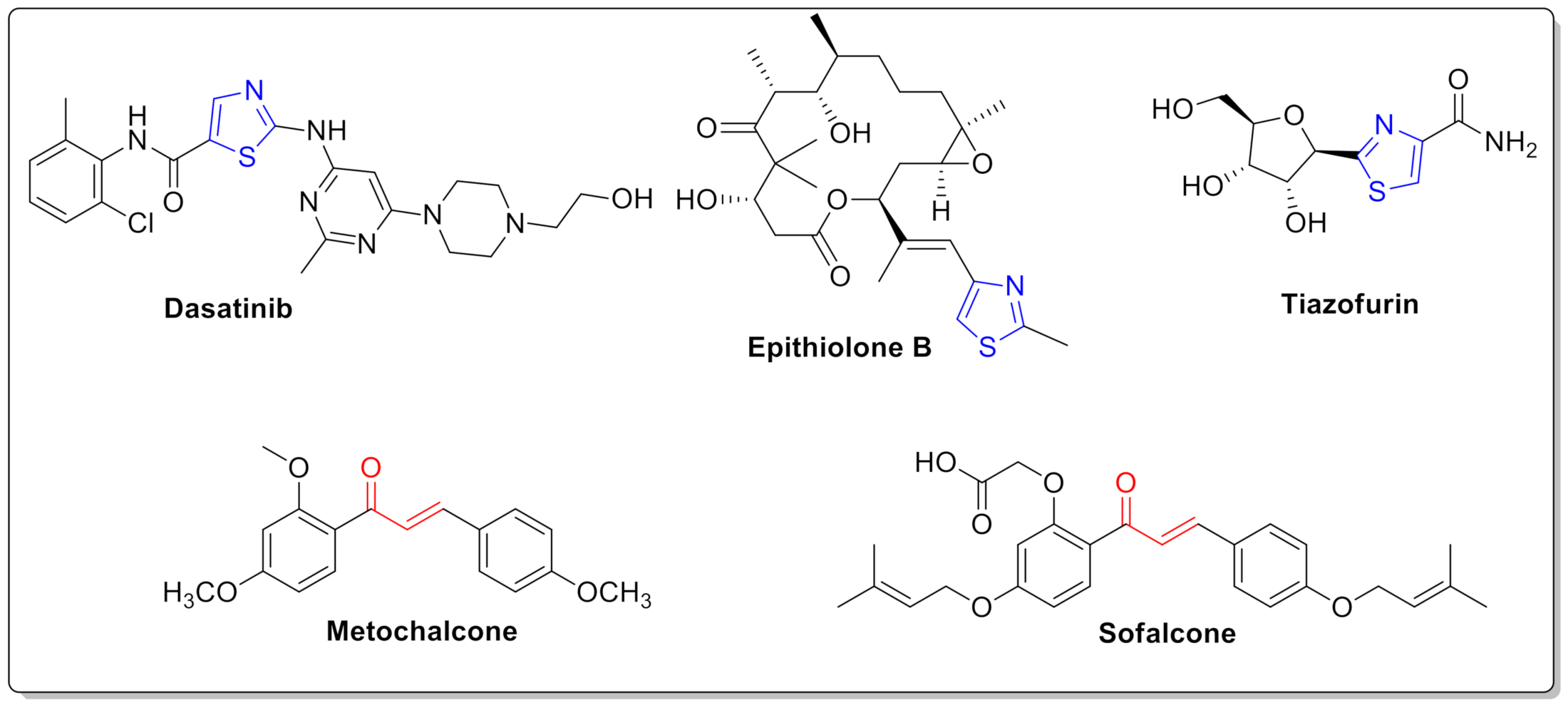

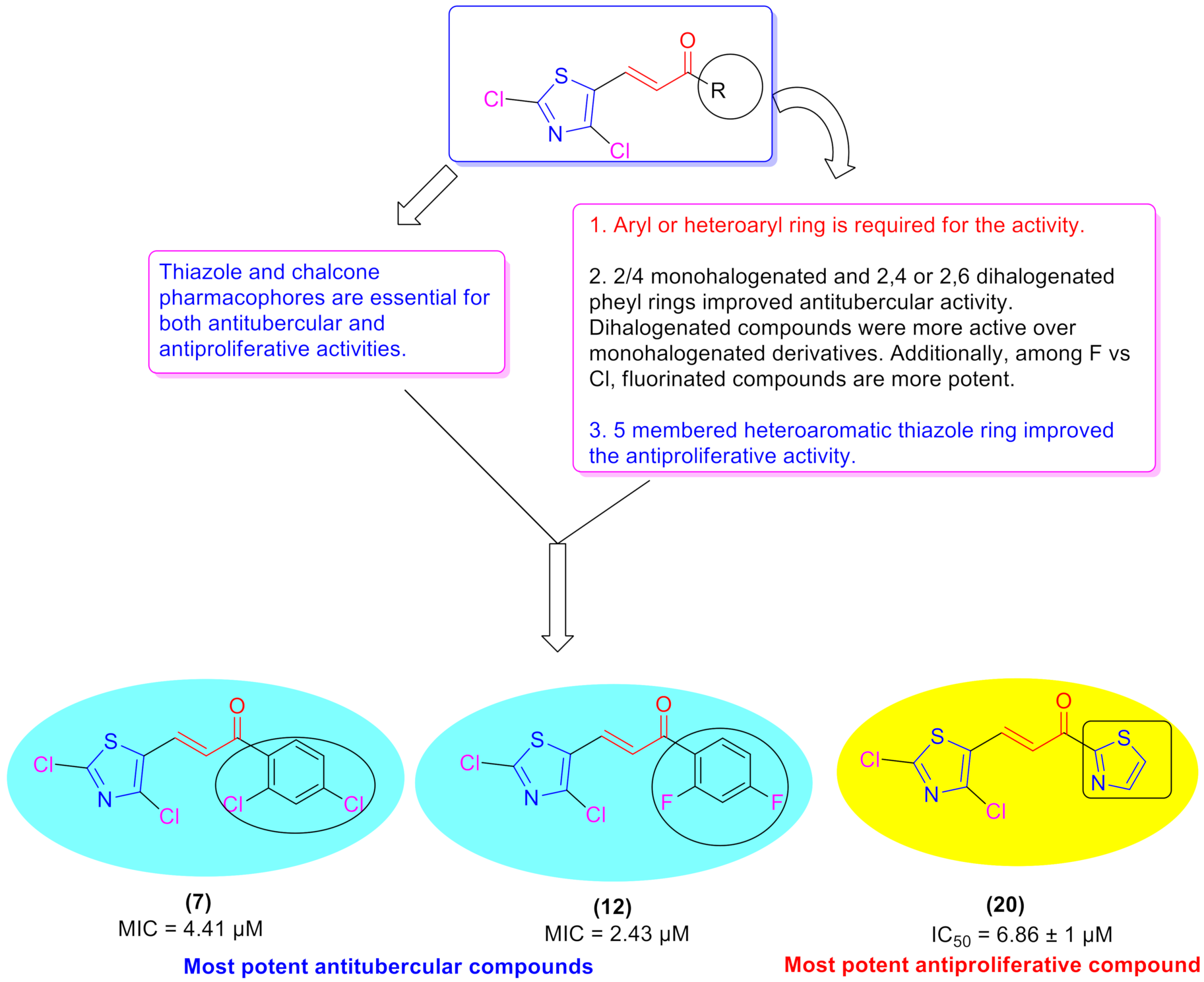
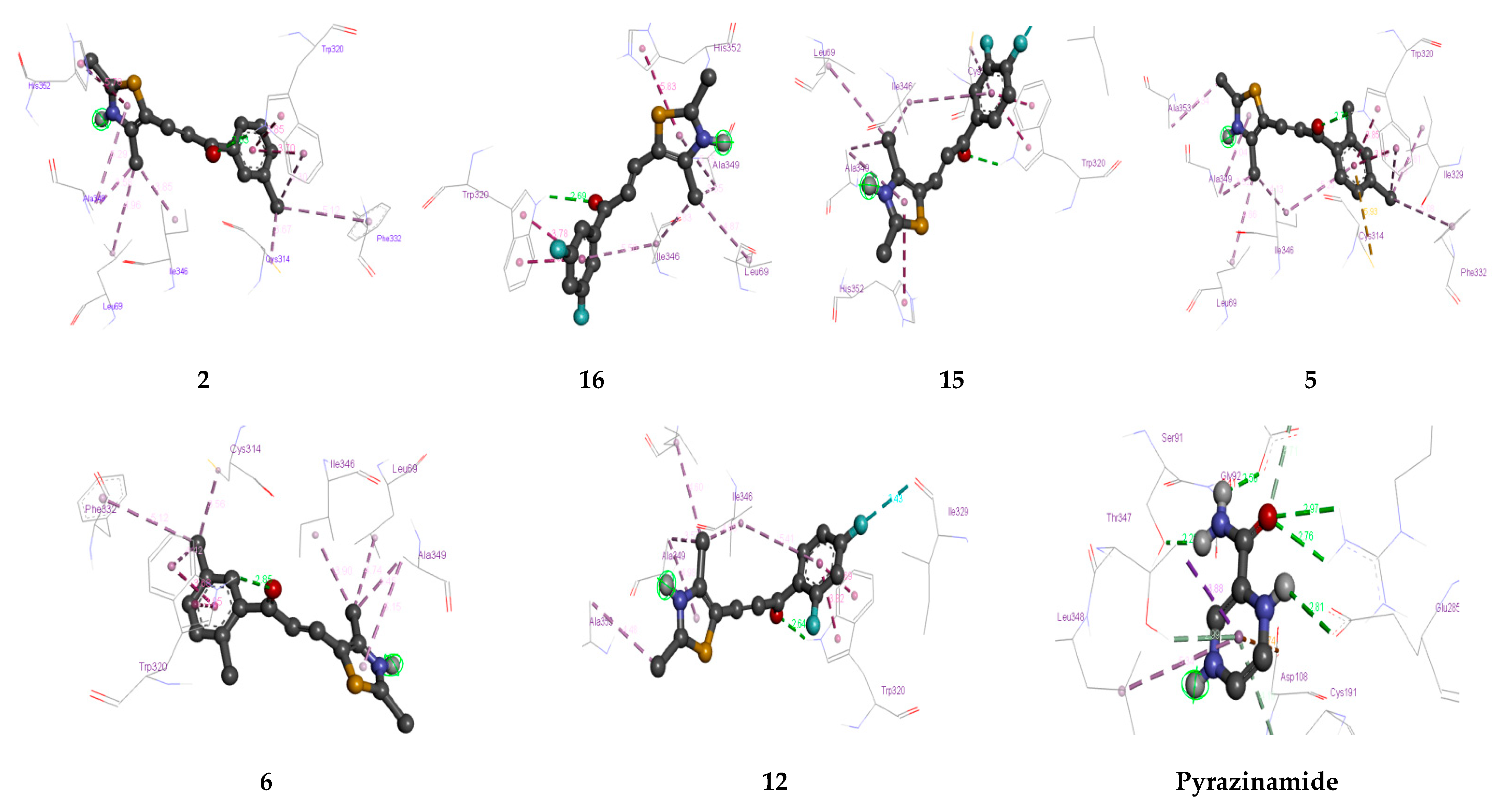
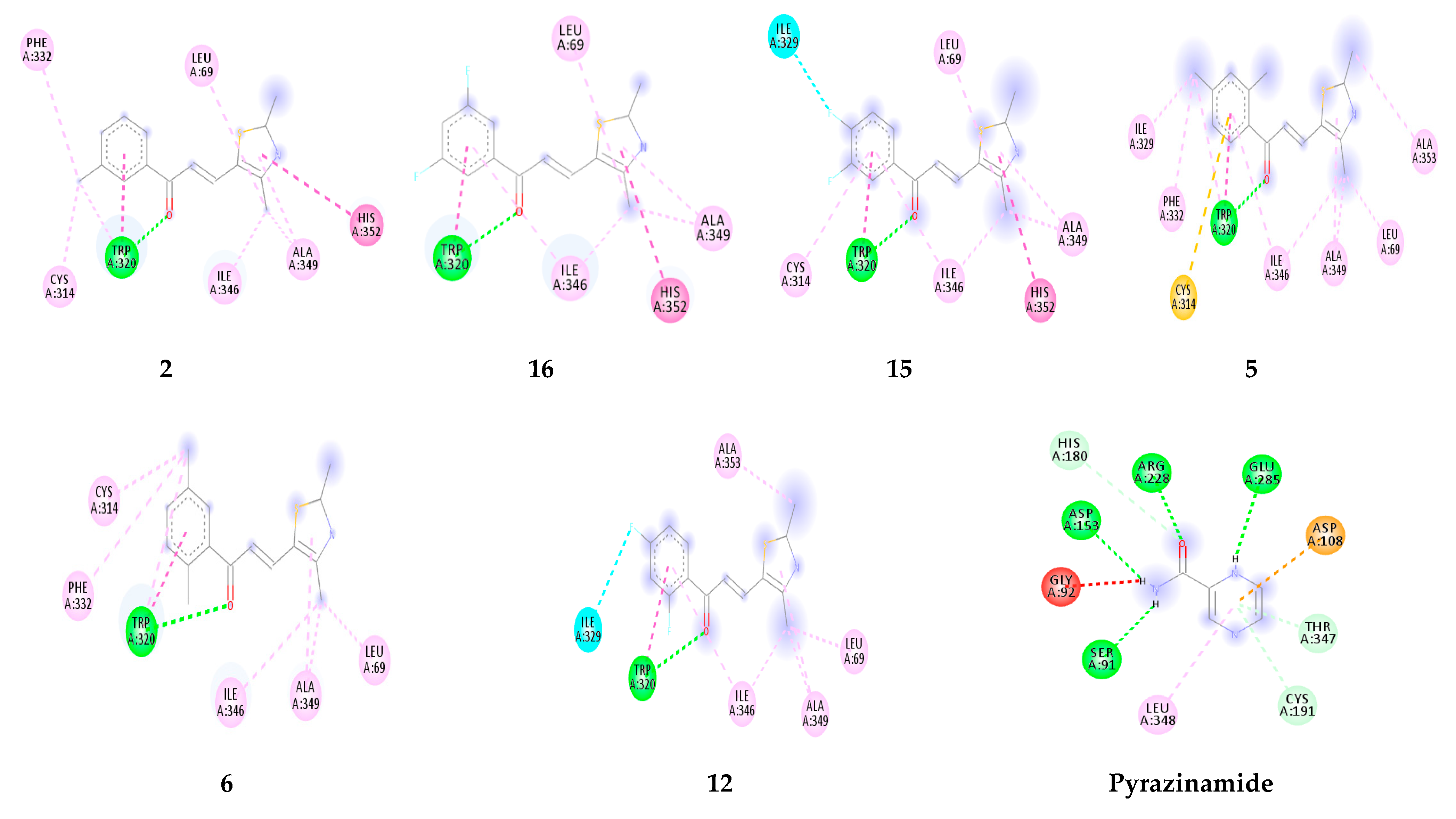
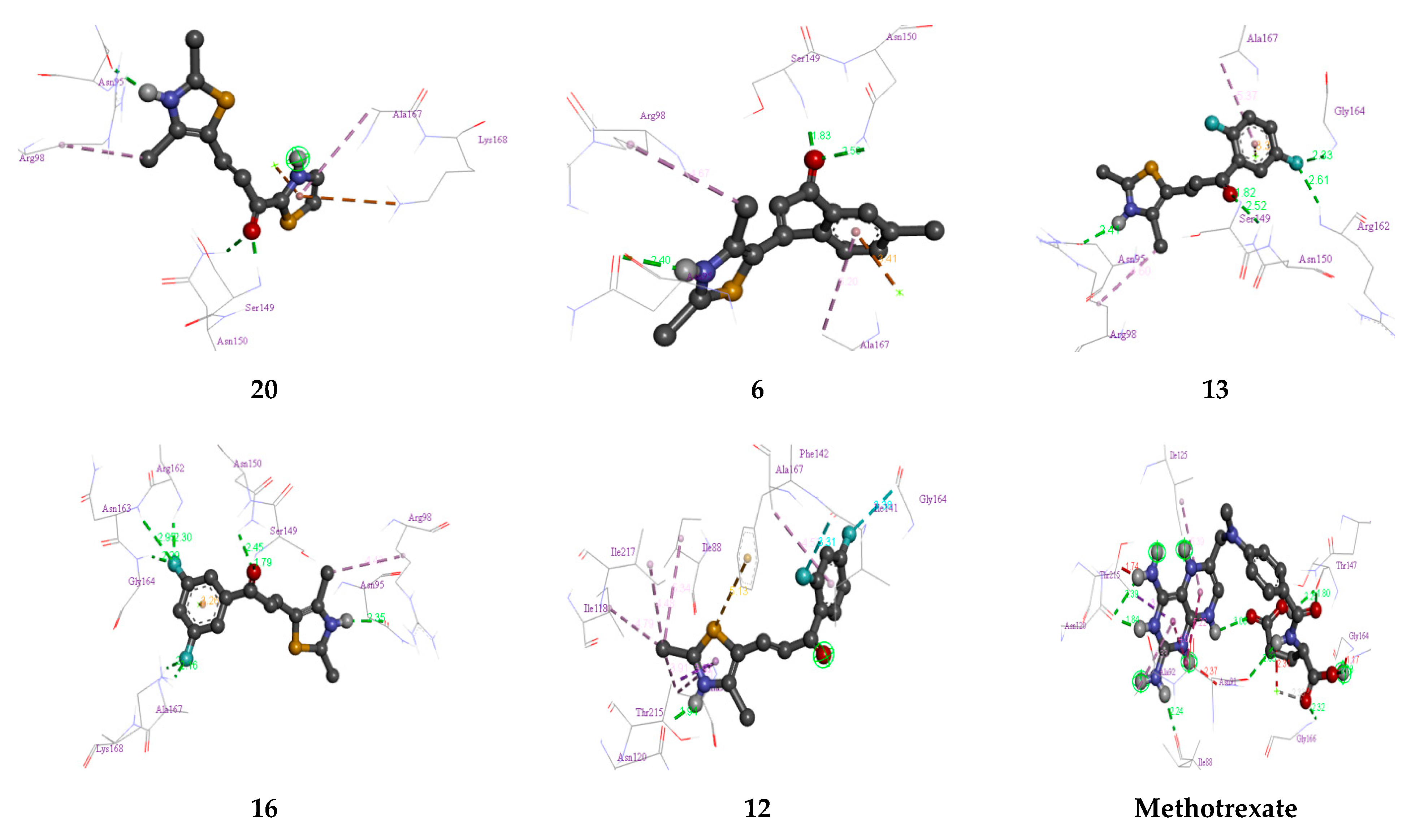
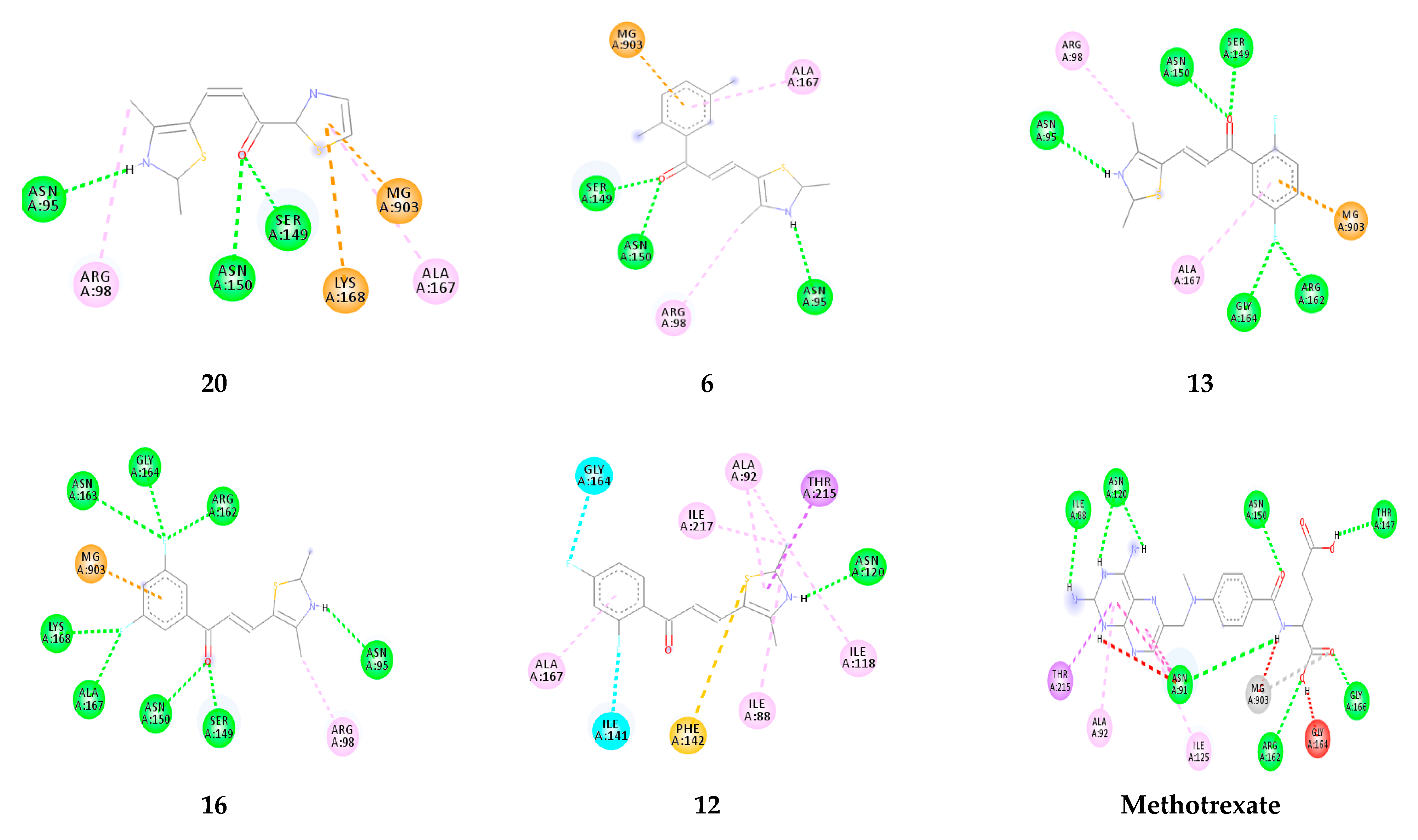


| Entry | R | Mtb (H37Rv Strain) (MIC in µM) a |
|---|---|---|
| 1 | 2-chlorophenyl | 78.46 ± 1 |
| 2 | 3-chlorophenyl | 313.87 ± 1 |
| 3 | 4-chlorophenyl | 78.46 ± 1 |
| 4 | 2,3-dichlorophenyl | 141.62 ± 2 |
| 5 | 2,6-dichlorophenyl | 35.40 ± 2 |
| 6 | 2,5-dichlorophenyl | 141.62 ± 1 |
| 7 | 2,4-dichlorophenyl | 4.41 ± 2 |
| 8 | 3,4-dichlorophenyl | 141.62 ± 1 |
| 9 | 2-fluorophenyl | 20.68 ± 2 |
| 10 | 3-fluorophenyl | 165.48 ± 1 |
| 11 | 4-fluorophenyl | 20.68 ± 1 |
| 12 | 2,4-difluorophenyl | 2.43 ± 1 |
| 13 | 2,5-difluorophenyl | 39.04 ± 1 |
| 14 | 2,6-difluorophenyl | 9.74 ± 2 |
| 15 | 3,4-difluorophenyl | 39.04 ± 1 |
| 16 | 3,5-difluorophenyl | 156.18 ± 2 |
| 17 | 2-pyridinyl | 350.70 ± 2 |
| 18 | 3-pyridinyl | 701.40 ± 1 |
| 19 | 4-pyridinyl | 350.70 ± 2 |
| 20 | 2-thiazolyl | 343.45 ± 1 |
| Pyrazinamide | 25.34 ± 2 |
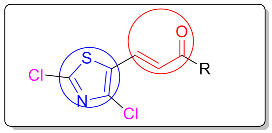
| Entry | R | Prostate Cancer Cell Line (DU-145) (IC50 in µM) b | Normal Liver Cell Line (L02) (IC50 in µg/mL) b |
|---|---|---|---|
| 1 | 2-chlorophenyl | 100.43 ± 2 | >70 |
| 2 | 3-chlorophenyl | 1607.03 ± 2 | >70 |
| 3 | 4-chlorophenyl | 401.75 ± 1 | >70 |
| 4 | 2,3-dichlorophenyl | 181.28 ± 1 | >70 |
| 5 | 2,6-dichlorophenyl | 90.64 ± 1 | >70 |
| 6 | 2,5-dichlorophenyl | 2900.52 ± 2 | >70 |
| 7 | 2,4-dichlorophenyl | 181.28 ± 1 | >70 |
| 8 | 3,4-dichlorophenyl | 1450.26 ± 1 | >70 |
| 9 | 2-fluorophenyl | 52.95 ± 2 | >70 |
| 10 | 3-fluorophenyl | 847.28 ± 2 | >70 |
| 11 | 4-fluorophenyl | 423.64 ± 2 | >70 |
| 12 | 2,4-difluorophenyl | 99.95 ± 1 | >70 |
| 13 | 2,5-difluorophenyl | 3198.70 ± 2 | >70 |
| 14 | 2,6-difluorophenyl | 24.98 ± 2 | >70 |
| 15 | 3,4-difluorophenyl | 799.67 ± 1 | >70 |
| 16 | 3,5-difluorophenyl | 3198.70 ± 1 | >70 |
| 17 | 2-pyridinyl | 14.02 ± 1 | >70 |
| 18 | 3-pyridinyl | 28.05 ± 1 | >70 |
| 19 | 4-pyridinyl | 14.02 ± 1 | >70 |
| 20 | 2-thiazolyl | 6.86 ± 1 | >70 |
| Methotrexate | 11 ± 1 | >70 |
| Compound | Binding Affinity | Compound | Binding Affinity | ||
|---|---|---|---|---|---|
| 1F8M | 1ZXM | 1F8M | 1ZXM | ||
| 1 | −6.7 | −8.1 | 11 | −7 | −7.8 |
| 2 | −7.3 | −8.1 | 12 | −7.1 | −8.2 |
| 3 | −7 | −7.7 | 13 | −7.2 | −8.4 |
| 4 | −6.9 | −7.9 | 14 | −6.8 | −8.2 |
| 5 | −7.2 | −7.9 | 15 | −7.2 | −8.2 |
| 6 | −7.2 | −8.1 | 16 | −7.3 | −8.3 |
| 7 | −6.6 | −8.1 | 17 | −6.3 | −7.6 |
| 8 | −6.8 | −8.1 | 18 | −6.2 | −7.7 |
| 9 | −6.9 | −8.1 | 19 | −6.2 | −7.7 |
| 10 | −7.1 | −8.1 | 20 | −5.7 | −9.3 |
| Methotrexate | - | −9.5 | Pyrazinamide | −5.4 | - |
| Compound | Docking Score | Amino Acids Interacted Through | |
|---|---|---|---|
| H-Bond | Hydrophobic | ||
| 2 | −7.3 | Trp320 | Leu69, Cys314, Phe332, Ile346, Ala349, His352 |
| 16 | −7.3 | Trp320 | Leu69, Ile346, Ala349, His352 |
| 15 | −7.2 | Trp320 | Lue69, Ile329, Cys314, Ile346, Ala349, His352 |
| 5 | −7.2 | Trp320 | Leu69, Ile329, Phe332, Ile346, Ala349, Ala353 |
| 6 | −7.2 | Trp320 | Leu69, Lys315, Phe332, Ile346, Ala349 |
| 12 | −7.1 | Trp320 | Leu69, Ile329, Ile346, Ala349, Ala353 |
| Pyrazinamide | −5.4 | Asp153, Arg228, Glu285, Asp108, Ser91, Leu348 | Cys191, Thr347, His180 |
| Compound | Docking Score | Amino Acids Interacted Through | |
|---|---|---|---|
| H-Bond | Hydrophobic | ||
| 20 | −9.3 | Asn95, Ser149, Asn150, Lys168 | Arg98, Ala167 |
| 6 | −8.5 | Asn95, Ser149, Asn150 | Arg98, Ala167 |
| 13 | −8.4 | Asn95, Ser149, asn150, Arg162, Gly164 | Arg98, Ala167 |
| 16 | −8.3 | Asn95, Ser149, Asn150, Arg162, Asn163, Gly163, Ala167, Ays168 | Arg98 |
| 12 | −8.2 | Asn120, Phe142 | Ile88, Ala92, Ile118, Ile141, Gly164, Ala167, Thr215, Ile217 |
| Methotrexate | −9.5 | Ile88, Asn120, Thr147, Asn150, Arg162, Gly164, Gly166 | Asn91, Ala92, Ile125, Thr215 |
| Compound # | GI Absorption | CYP2C19 Inhibitor | CYP2D6 Inhibitor | Lipinski #Violations |
|---|---|---|---|---|
| 7 | High | Yes | No | 0 |
| 14 | High | Yes | No | 0 |
| 20 | High | Yes | No | 0 |
Publisher’s Note: MDPI stays neutral with regard to jurisdictional claims in published maps and institutional affiliations. |
© 2021 by the authors. Licensee MDPI, Basel, Switzerland. This article is an open access article distributed under the terms and conditions of the Creative Commons Attribution (CC BY) license (https://creativecommons.org/licenses/by/4.0/).
Share and Cite
Kasetti, A.B.; Singhvi, I.; Nagasuri, R.; Bhandare, R.R.; Shaik, A.B. Thiazole–Chalcone Hybrids as Prospective Antitubercular and Antiproliferative Agents: Design, Synthesis, Biological, Molecular Docking Studies and In Silico ADME Evaluation. Molecules 2021, 26, 2847. https://doi.org/10.3390/molecules26102847
Kasetti AB, Singhvi I, Nagasuri R, Bhandare RR, Shaik AB. Thiazole–Chalcone Hybrids as Prospective Antitubercular and Antiproliferative Agents: Design, Synthesis, Biological, Molecular Docking Studies and In Silico ADME Evaluation. Molecules. 2021; 26(10):2847. https://doi.org/10.3390/molecules26102847
Chicago/Turabian StyleKasetti, Ashok Babu, Indrajeet Singhvi, Ravindra Nagasuri, Richie R. Bhandare, and Afzal B. Shaik. 2021. "Thiazole–Chalcone Hybrids as Prospective Antitubercular and Antiproliferative Agents: Design, Synthesis, Biological, Molecular Docking Studies and In Silico ADME Evaluation" Molecules 26, no. 10: 2847. https://doi.org/10.3390/molecules26102847
APA StyleKasetti, A. B., Singhvi, I., Nagasuri, R., Bhandare, R. R., & Shaik, A. B. (2021). Thiazole–Chalcone Hybrids as Prospective Antitubercular and Antiproliferative Agents: Design, Synthesis, Biological, Molecular Docking Studies and In Silico ADME Evaluation. Molecules, 26(10), 2847. https://doi.org/10.3390/molecules26102847






